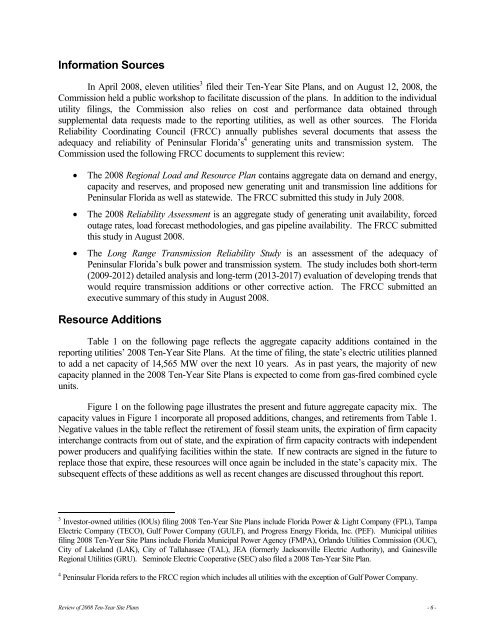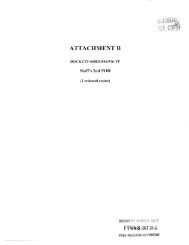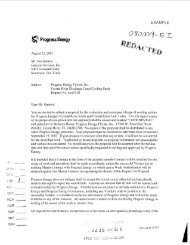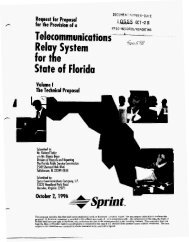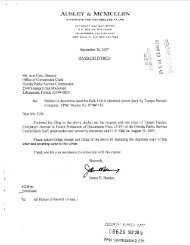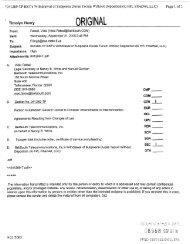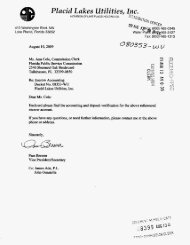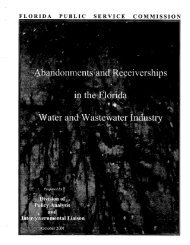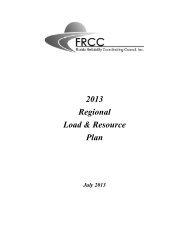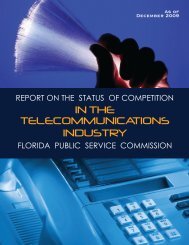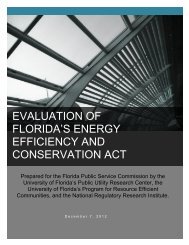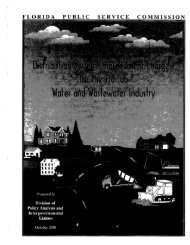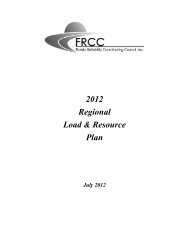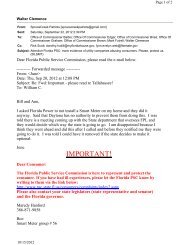Review of 2008 Ten-Year Site Plans - Public Service Commission
Review of 2008 Ten-Year Site Plans - Public Service Commission
Review of 2008 Ten-Year Site Plans - Public Service Commission
You also want an ePaper? Increase the reach of your titles
YUMPU automatically turns print PDFs into web optimized ePapers that Google loves.
Information Sources<br />
In April <strong>2008</strong>, eleven utilities 3 filed their <strong>Ten</strong>-<strong>Year</strong> <strong>Site</strong> <strong>Plans</strong>, and on August 12, <strong>2008</strong>, the<br />
<strong>Commission</strong> held a public workshop to facilitate discussion <strong>of</strong> the plans. In addition to the individual<br />
utility filings, the <strong>Commission</strong> also relies on cost and performance data obtained through<br />
supplemental data requests made to the reporting utilities, as well as other sources. The Florida<br />
Reliability Coordinating Council (FRCC) annually publishes several documents that assess the<br />
adequacy and reliability <strong>of</strong> Peninsular Florida’s 4 generating units and transmission system. The<br />
<strong>Commission</strong> used the following FRCC documents to supplement this review:<br />
• The <strong>2008</strong> Regional Load and Resource Plan contains aggregate data on demand and energy,<br />
capacity and reserves, and proposed new generating unit and transmission line additions for<br />
Peninsular Florida as well as statewide. The FRCC submitted this study in July <strong>2008</strong>.<br />
• The <strong>2008</strong> Reliability Assessment is an aggregate study <strong>of</strong> generating unit availability, forced<br />
outage rates, load forecast methodologies, and gas pipeline availability. The FRCC submitted<br />
this study in August <strong>2008</strong>.<br />
• The Long Range Transmission Reliability Study is an assessment <strong>of</strong> the adequacy <strong>of</strong><br />
Peninsular Florida’s bulk power and transmission system. The study includes both short-term<br />
(2009-2012) detailed analysis and long-term (2013-2017) evaluation <strong>of</strong> developing trends that<br />
would require transmission additions or other corrective action. The FRCC submitted an<br />
executive summary <strong>of</strong> this study in August <strong>2008</strong>.<br />
Resource Additions<br />
Table 1 on the following page reflects the aggregate capacity additions contained in the<br />
reporting utilities’ <strong>2008</strong> <strong>Ten</strong>-<strong>Year</strong> <strong>Site</strong> <strong>Plans</strong>. At the time <strong>of</strong> filing, the state’s electric utilities planned<br />
to add a net capacity <strong>of</strong> 14,565 MW over the next 10 years. As in past years, the majority <strong>of</strong> new<br />
capacity planned in the <strong>2008</strong> <strong>Ten</strong>-<strong>Year</strong> <strong>Site</strong> <strong>Plans</strong> is expected to come from gas-fired combined cycle<br />
units.<br />
Figure 1 on the following page illustrates the present and future aggregate capacity mix. The<br />
capacity values in Figure 1 incorporate all proposed additions, changes, and retirements from Table 1.<br />
Negative values in the table reflect the retirement <strong>of</strong> fossil steam units, the expiration <strong>of</strong> firm capacity<br />
interchange contracts from out <strong>of</strong> state, and the expiration <strong>of</strong> firm capacity contracts with independent<br />
power producers and qualifying facilities within the state. If new contracts are signed in the future to<br />
replace those that expire, these resources will once again be included in the state’s capacity mix. The<br />
subsequent effects <strong>of</strong> these additions as well as recent changes are discussed throughout this report.<br />
3 Investor-owned utilities (IOUs) filing <strong>2008</strong> <strong>Ten</strong>-<strong>Year</strong> <strong>Site</strong> <strong>Plans</strong> include Florida Power & Light Company (FPL), Tampa<br />
Electric Company (TECO), Gulf Power Company (GULF), and Progress Energy Florida, Inc. (PEF). Municipal utilities<br />
filing <strong>2008</strong> <strong>Ten</strong>-<strong>Year</strong> <strong>Site</strong> <strong>Plans</strong> include Florida Municipal Power Agency (FMPA), Orlando Utilities <strong>Commission</strong> (OUC),<br />
City <strong>of</strong> Lakeland (LAK), City <strong>of</strong> Tallahassee (TAL), JEA (formerly Jacksonville Electric Authority), and Gainesville<br />
Regional Utilities (GRU). Seminole Electric Cooperative (SEC) also filed a <strong>2008</strong> <strong>Ten</strong>-<strong>Year</strong> <strong>Site</strong> Plan.<br />
4 Peninsular Florida refers to the FRCC region which includes all utilities with the exception <strong>of</strong> Gulf Power Company.<br />
<strong>Review</strong> <strong>of</strong> <strong>2008</strong> <strong>Ten</strong>-<strong>Year</strong> <strong>Site</strong> <strong>Plans</strong> - 6 -


